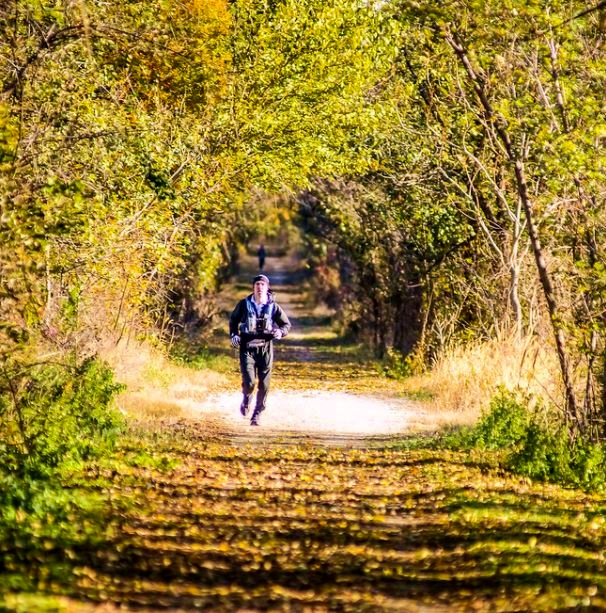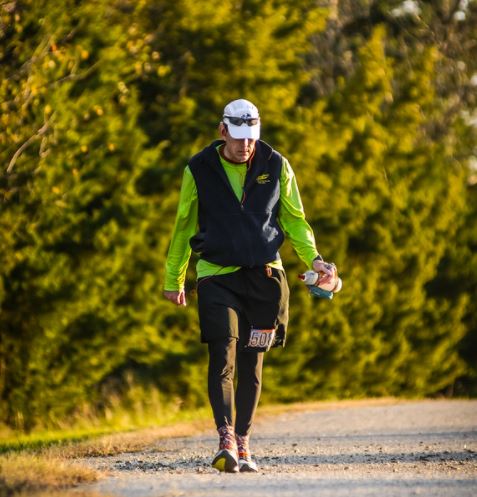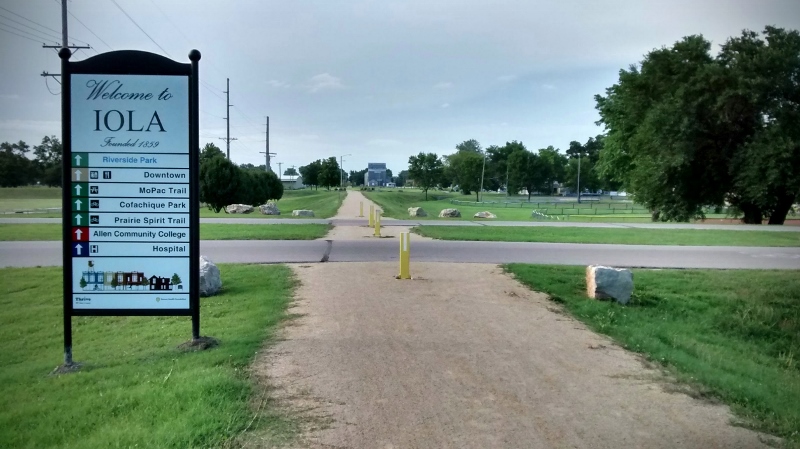I ran a relatively new 100-miler, the Kansas Rails-To-Trails 100 held in eastern Kansas, part of the Kansas Rails-to-Trails Fall Ultra Extravaganza. The course really intrigued me, running on a former rail bed, the 51-mile Prairie Spirit Trail. There is also a spring edition of this race.
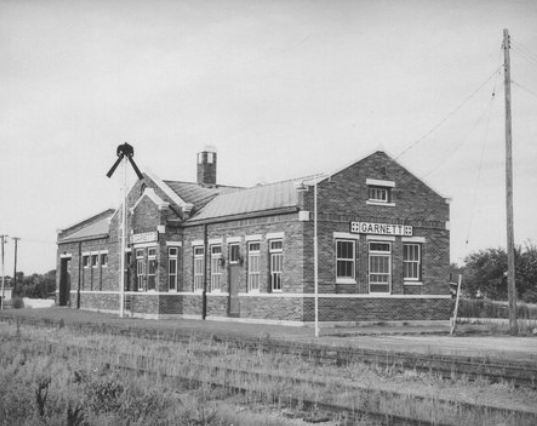
In 1867 construction began of a 143-mile rail line running north/south through eastern Kansas and was completed in 1871 connecting a number of small towns. During the 1880s, passengers rode on the train at speeds up to 35 m.p.h. The rail line was active until 1990 when it was abandoned after being sold. The Kansas Department of Wildlife and Parks was granted title in 1992 for a recreational trail. By 2008, a 51-mile stretch of the trail had been developed and named the Prairie Spirit Trail.
The Prairie Spirit trail is a combination of paved trail through the towns and smooth hard-packed crushed limestone as it goes across the prairie. The trail is maintained very well, is free of rocks, and averages eight feet wide. It is very flat with no perceived hills. The 100-mile course runs nearly the length of the trail, an out-and-back from Ottawa to Iola and back and climbs only about 1,100 feet.
As race day approached I realized that the run would be very chilly but rain-free. During the day we would have a tail wind with temperatures between about 28 and 45 degrees. It was important for me to figure out the right clothes combination to allow me to run warm but without sweating much. I carefully planned my drop bags that would be at each little town along the rail line, bringing plenty of warm clothes for options. With all that careful planning, I chose correctly at the start and never needed to change clothes and put on other layers. During the day I only took off arm sleeves and during the night I switched out gloves for mittens.
My goal was to finish for sure, hopefully faster than 24-hours and I felt that 22 hours was within my capability. I put together a pacing chart based on my past flat races to give me something to shoot for. But with my slow races this past summer, I had no idea how well I would do.

The field for the 100-mile race was small, about 24 of us, including some very fast runners. Six of the field would drop out along the way. We started in the dark at 6:00 a.m., first doing a two-mile out-and-back to the north and then we would head 49 miles to our turnaround at Iola. I first ran with about five runners in the front, but after a quarter mile, wanted to stretch out my legs and run faster. I pressed ahead into the lead running at 8-minute-mile pace. I was pleased with my pace and how well I initially felt. At about mile 3.5 several runners caught up and passed me. I had slowed to about 8:45 pace. The leading woman runner (and eventual winner among the women) caught up and we would leap-frog each other for the next 20 miles.
A beautiful smoky sunrise came into view to the east but the trail was lined on both sides by trees for miles and miles. We would run through a tunnel of fall trees for long stretches without much else to see. The really interesting views appeared when we neared and went through the towns. The amazing smooth trail would cross remote rural roads along the way letting us see the surrounding farms. As the sun started to rise, it really didn’t warm things up for several hours. It was pretty cold but my pace kept me warm and the wind was mostly at our backs.
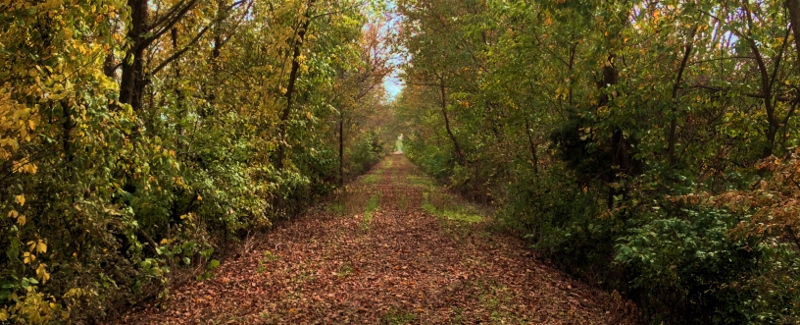
I reached the first town, Princeton (mile 9.2) where I put my headlamp in my drop bag and downed some quick food. I arrived there at 1:21, twenty-four minutes ahead of my planned pace. My pace was still strong and my first mile over ten minutes wouldn’t come until mile 15. I was running in about 7th place. My problem knee started to complain, giving me worries whether it would hold up for 100 miles, so I backed off the pace a bit. I next arrived to cheers at a park in Richmond (mile 15.7), at 2:25, now 40 minutes ahead of my schedule. The aid stations were rather far apart, seven to ten miles between them, but there were unmanned water jugs placed about half-way between them.
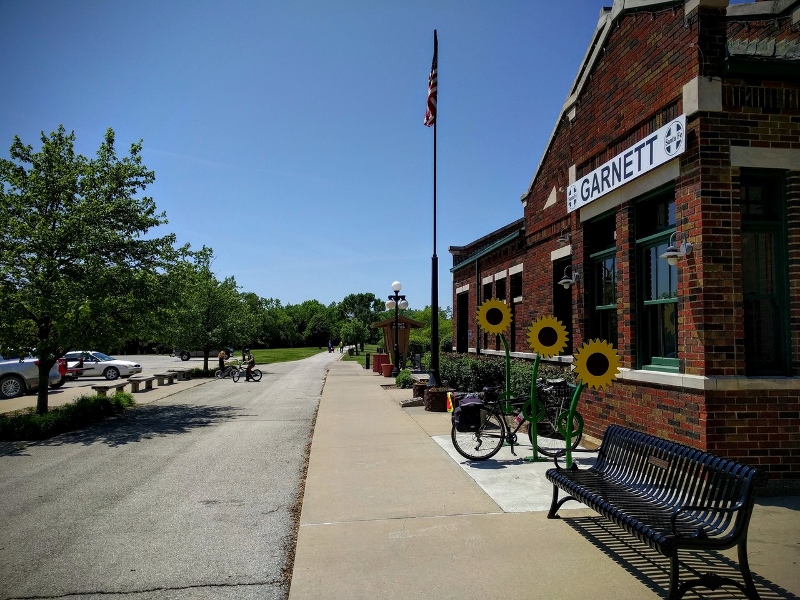
By mile 21, my pace had slowed to over 10-minute miles and when I reached the bigger town of Garnett (mile 24.8), I was feeling fatigued and welcomed a rest. I arrived at 3:56 and was 49 minutes ahead of my planned pace. The aid station was in a small warm old railroad depot and I stopped to access my drop bag and use the bathroom, resting for about ten minutes. For fuel during the first 50 miles I drank mostly diluted Ensure, Ginger ale, ate gels and sucked down strawberry/yogurt baby food.
While stopped, I had been passed by several runners due to my long stop. I hit the marathon mark at 4:17 which is a solid split time for me during a flat 100-miler. I was pleased and focused on the 50K split which came at 5:11. Despite the constant tunnel of trees, the trail had beautiful early fall colors and I enjoyed at times running through soft leaves. The route would cross bridges over streams and roads along the way. My problem knee calmed down but my quads became sore from the constant, consistent motion on the flat surface.
Yes, it was flat but I caught up to two runners who were walking a long stretch. We greeted each other and one of them commented on the hill. Hill? I looked ahead and realized that it was gaining a little elevation (only about 150 feet in four miles). I was amused that anyone would notice it. I ran on at my constant pace. I guess that is considered a hill in Kansas. When the views opened up at times I could see just flat plains in all direction with no mountains or hills to be seen everywhere. I thought of Wizard of Oz and said out loud, “We’re not in Utah anymore.”
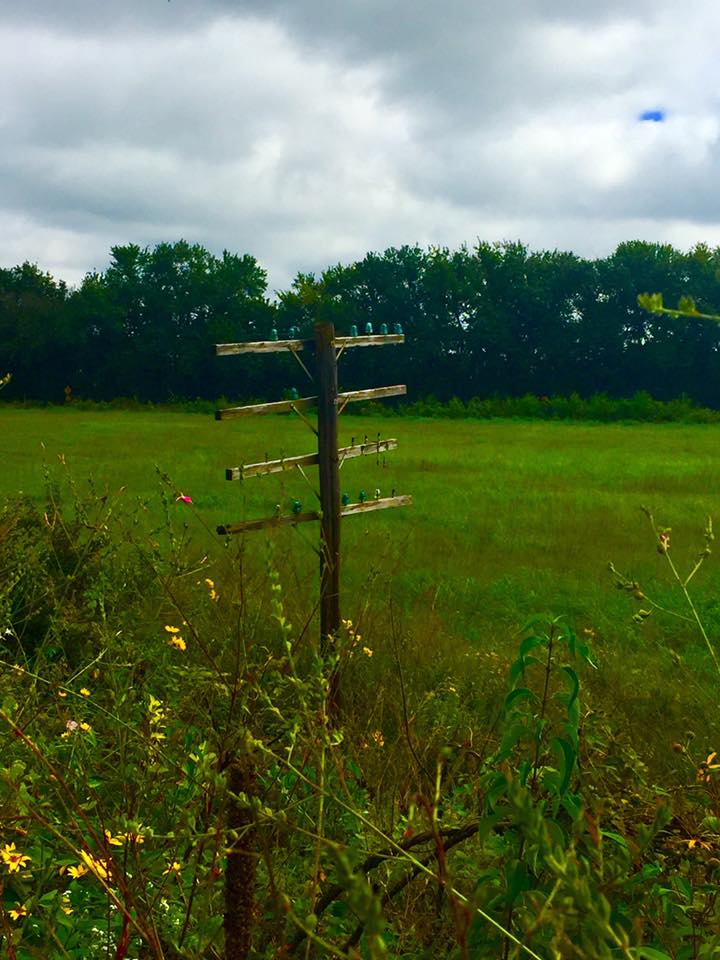
By mile 32 my pace had now slowed to a consistent 11:30 mile pace. I arrived at Welda (mile 33.4) at 5:37, 43 minutes ahead of schedule. I sat for four minutes to eat/drink well. It was finally starting to warm up, but each time I considered taking off a layer, it would still feel cold among the trees on the trail. The next six miles were a pain, running right next to a noisy freeway and it was nice to finally get away from it.
I arrived at Colony (mile 41.1) at 7:11, 39 minutes ahead of schedule. All the volunteers at the aid stations were amazing and very helpful to our small group of runners. The stations had plenty of good food, my only complaint is that they used Gatorade, a rarely used drink in 100s because it is hard on the stomach. My stomach continued to do OK with my diluted Ensure. As I got sick of the sweet taste, I switched to straight water for a while. It finally became warmer and the tree tunnel disappeared giving wide open views. I took off my arm sleeves, my ear fleece, putting them in my pockets.
The turnaround point would be my next stop and I was curious when I would see the first runner coming back. He came earlier than expected, about nine miles ahead of me. I was surprised at the number of runners who were far ahead of me. It was a strong field. As I counted the runners, I determined that I was in 11th place. I focused on reaching the 50-mile mark and arrived there at 9:07, still a solid time for me while running a 100-miler. I reached the turnaround in Iola (mile 51) at 9:22, 43 minutes ahead of schedule. I was in good spirits. After a five minute stop, joking with the volunteers, I was on my way again. Now all I needed to do was to return back to Ottawa.
I greeted the runners behind me but was very surprised to discover that there were only about seven runners behind and only four in what would be considered the back-of-the pack. I was now running slower with short periods of walking, averaging about 13:30 miles, still staying ahead of schedule. Thankfully the wind had calmed down and shifted around from the southwest so we would have a tail wind on the way back.
I returned to Colony (mile 60.9) before sunset at 11:49, still 41 minutes ahead of schedule. I had planned to change into fresh clothes there, but I felt fine so stuck with everything I wore. I grabbed my faithful green flashlight and got back on the rail bed, arriving at the 100K mark at 12:10. As darkness arrived, my race started to fall apart as my pace slowed to 16-minute miles at times. The temperature fell below freezing and the noisy freeway nearby annoyed me. I arrived back at Welda (mile 68.6) at 13:57, now 28 minutes ahead of schedule. At each aid station during the night, I stopped to sit in front of the heater to regroup and eat. After six minutes I was on my way again.
Things soon started to crumble. With the cold breeze, my eyes got cold and as I closed them to short times to warm them up, I became very drowsy. Soon I was stumbling along the trail and zig-zagging into a strip of grass and leaves bordering the trail. Thankfully I never fell off the steep slope of the rail bed into the thick brush and trees. With the tunnel of trees, there were not things to see and think about. Occasionally I would hear a critter scrambling away from me in the brush as I ran by.
Finally as I noticed my pace was falling slower than 16-mile pace, I knew that I needed to stop and rest. At mile 74.8 I found a nice soft area beside the trail with leaves and grass. It felt surprisingly warm as I laid down. I turned out my light and calmed down my heart rate and respiration. Usually all it takes is about one minute of light sleep and then I am good to go for a least an hour.
As I was still resting, a male runner with a young female pacer came upon me. They shined their lights on me, asking “Are you OK?” I replied, “Yes, just taking a cat nap.” Usually that works and the people go on. The young lady pacing, who obviously was pacing her first 100-miler, could not believe that I was OK and was alarmed that I was alone. “Are you sure?” “Yes, I’m trying to sleep, please go on.” She wouldn’t go on and kept the concerned questions coming. Finally I had to plead for her to leave me alone that I was doing perfectly fine, just resting. As she left, she called back that she wanted to report to the next aid station that I was laying down on the trail and wanted my number and name. I didn’t reply because there was no reason to worry an aid station for no reason. Finally she went on. I chuckled about the experience. After a couple more minutes, I knew sleep wouldn’t come so I popped back up and started running fast again. I nearly caught up to the couple. What is funny about this, is that a couple hours later they were running behind me and I noticed that they were making stops, turning out their lights. I suspect he was taking cat naps too.
The town of Garnett was beautiful at night with lights reflecting off a small lake and a big noisy factory in operation converting corn to ethanol. I arrived there (mile 77.2) at 16:27, only three minutes ahead of schedule. I knew that I had lost my pace cushion for a 22-hour finish. But I was in great spirits, feeling well and joked around with the volunteers. The running couple sat silently on the side, working on the runner’s feet. I was told by one volunteer that most of the runners were getting blisters on the balls of their feet. My feet were doing perfect and I would finish without any blisters. I always tape the balls of my feet for a fast, flat races. At one aid station I took off a shoe and discovered there was no grit at all, but I changed into a dry sock.
A pattern continued through the night. The aid stations seemed very far apart and I would get very drowsy between them. I stopped for about four more cat naps, losing about a total of 40 minutes along the way. Turning on my bright headlamp seemed to help keep me awake better. After each rest I jumped back up alert and could run 12-minute-mile pace again for a while. Sometimes the trail went in tunnels under roads and I had fun making train noises that really echoed loudly. For the lingering miles of a 100, I think about milestones along the way such as 50K left, a marathon left, and 20 miles left. I reached Richmond (mile 86.3) at 19:15, 40 minutes behind schedule. I warmed up there for ten minutes. The volunteers mentioned that there was just a half marathon left and I joked that it should surely only take two hours.
The next 9.1 miles to Princeton were long, cold and slow. In addition to a neck fleece, I took out a bandana to cover my nose and mouth. My pace had degraded to 17-minute miles. I arrived back at Princeton (mile 92.8) at 21:28, now far off my pace goal. I stopped for seven minutes to warm up, recover, and eat. Each time new life would come back with amazing quickness and I commented that I had recovered well.
OK, I had 7.2 miles to cover in less than 2:25 in order to go sub-24-hours. I ran the numbers in my tired head and realized I needed to average no more than 20-minute miles the rest of the way. The first mile was 16 minutes, so I knew I had a four minute cushion and I built that to 12 minutes over the next two miles. But then I needed another cat nap and was back down to a two minute cushion. With the urgency, I no longer felt drowsy, pushed harder and even clocked a 14:41 mile in my tired and sore state. The lights of Ottawa finally came into view between the trees and I knew I would make it in time. I crossed the finish line at 23:47:27 in 12th place. Any 100-mile finish in the dark is a solid finish.
I was very pleased and felt amazing at the finish, much better than most of my other 100-mile finishes. The big difference was the cool weather with no dehydration periods. My feet felt fine but my quads were very sore. I even commented to myself that the run had been a lot of fun. I am likely to return. All my drop bags were already returned to the finish. The staff did a great job making sure bags were back early.
I drove to my motel room, just a mile away, showered, texted my wife, and was resting in bed within an hour of finishing. After three hours of rest and some sleep, I drove the hour ride back to Kansas City and took my flight home. My 95th 100-miler was complete. Just five more to go.







